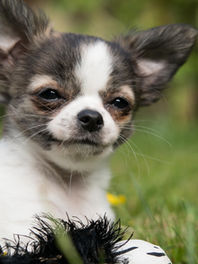Dogs and Kids: When 'fine' is not that great.
- Dr Jen Nesbitt-Hawes BVSc MVSt MANZCVS
- Jan 18, 2024
- 3 min read

This beautiful artwork perfectly captures an interaction between a child with the best of intentions and the dog on the receiving end of her affections. If the question were asked of most parents/guardians, they would probably say, "Oh, he's fine with children". However, this dog is not 'fine'. How can we tell? Body language. This dog is uncomfortable with this interaction. Let's look at some specifics:
1. Tense body. One of the best ways to tell whether a dog is relaxed and comfortable is if he has soft muscles, or bouncy play. This is a still image, but the rigid appearance of the legs and stiff positioning is clear.
2. Mouth closed. Dogs who are relaxed will often have an open mouth, perhaps with a tongue lolling out the side.
3. Tail low. Now, tails can be confusing things (a wag is not always a happy sign), but happy dogs tend to hold their tail out in a 'neutral' position; not too high or too low.
4. Furrowed brow. Much like us, dogs get a wrinkly forehead when they're worried about something.
5. Looking away. The dog is not looking at the girl or her book but has his gaze away from both. If a dog turns his gaze away, it's a good indication he doesn't want to interact.
So what? He's OK, isn't he? She's not hurting him and she's enjoying his company. He's not pulling away or growling. Surely he'd get away if he really wanted to?
Well, here's the thing. This dog is saying very politely that he is uncomfortable and would like the interaction to stop. If a child is allowed to continue doing things that make a dog uncomfortable, then he will have to try to make his message clearer. Perhaps he might growl- if so, the horrified parents often punish the dog for growling. So next time the dog doesn't growl, but feels more and more uncomfortable, until it bites - "out of nowhere". In fact, on most occasions that dogs bite children, the dog is a known dog, interacting in a home environment.
This is obviously a situation we want to avoid. What should we do instead?
1. Learn dog body language, particularly the early signs that a dog is uncomfortable (more posts on this coming up, so keep following to find out more). Teach children what to look for, too.
2. Always supervise kids and dogs if they are together. If there is no supervision, use barriers to make sure the children and dogs each have their own comfortable, safe places.
3. Respect the dog. When you see the dog looking uncomfortable, or you aren't sure he is enjoying himself, then stop the interaction, give the dog some space and let him move away if he wants to.
4. Teach kids house rules about when it is best to leave dogs alone (e.g. when the dog is sleeping, eating, chewing, unwell, resting, hiding, painful, or focused on something else).
5. Tell kids to call the dog over whenever they want to interact, instead of the child approaching the dog. If the dog doesn't approach them, then it doesn't want the interaction and it's better to wait for another occasion.
6. Teach kids appropriate fun ways of interacting with the dog. This may include teaching the dog tricks, playing fetch with a toy (as long as the dog is not possessive and the child doesn't ever take toys out of the dog's mouth), or going for a walk as a family (with an adult holding the leash).
7. Don't punish the warning signs. A growl is clear communication that a dog is uncomfortable. Immediately stop the interaction and mentally thank the dog for the valuable information. Then make a plan with a qualified trainer or behaviour veterinarian about what to do to prevent the situation from escalating.
Dogs and kids can be great friends. The very best friendships have good communication and mutual respect. Don't just assume that the dog is 'fine' - start watching those interactions with fresh eyes - your dog will thank you for it!
By Dr Jen of Pet Perspective































Comments